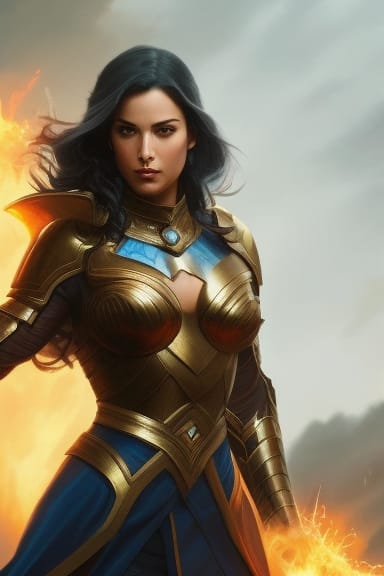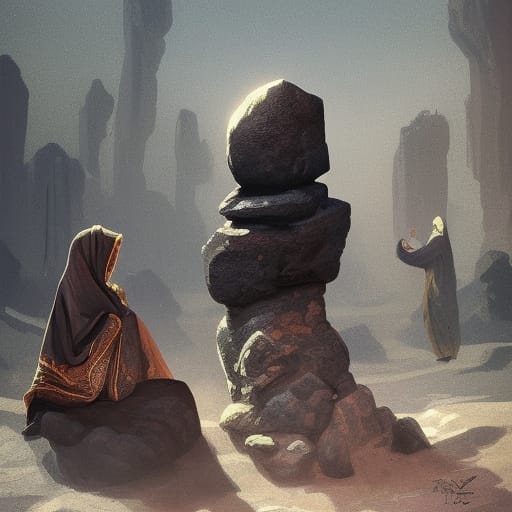Amazon nation

A nation of female warriors known as the Amazons. They live in the region bordering Scythia in what is now modern-day Ukraine and Asia Minor or Libya. The Amazons were known for their powerful queens such as Penthesilea, who fought in the Trojan War, and Hippolyta, who possessed a magical girdle sought after by Hercules. They were depicted as skilled warriors in battles against Greek warriors, and their legend continues to captivate people to this day.
The Amazons were a matriarchy, led by warrior-queens or high priestesses. Each tribe had two queens, one for defense and one for domestic affairs. They were also known for their wars against the people of Atlantis and their past attack on Hellas, led by Hippolyte. However, some Amazon tribes, led by Penthesilia, fought to defend Troy against the forces of Agammenon.
The Amazons had a strong belief in their religion, and their best warriors came from their priestess caste. Their main deity was Artemis, with some of the more violent tribes worshiping Ares. They shared the same pantheon of gods as the Greeks.
Their weapons were consistent, including the bow (a tribute to Artemis), the double-headed battle axe, crescent-shaped shields (another tribute to the Moon Goddess), spears, and javelins. The Amazons were a powerful and fascinating nation, and their legacy continues to inspire people to this day.
The Amazons were known for their unique cultural practices. They were known to pinch off the right breast of female infants so that they could throw the javelin without hindrance. However, they would preserve the left breast so that the female child could nurse their children through normal sexual intercourse with the other sex.
Another notable cultural practice was their treatment of male children. They were said to maim the male children by removing either a leg or a hand.
Their main pursuits included war, hunting, agriculture and training young Amazon girls in these areas. These women warriors were known for their martial skills and bravery in battle.
Amazon Class
Class: Amazon
Hit Dice: 1d10 per Amazon level
Armor Proficiency: Light and medium armor, shields
Weapon Proficiency: Simple and martial weapons
Class Features:
- Fighting Style: At 1st level, you choose a fighting style from the following options: Archery, Defense, Dueling, Great Weapon Fighting, Mariner, and Two-Weapon Fighting.
- Amazonian Heritage: At 1st level, you gain proficiency in the Athletics and Survival skills. Additionally, you can use your bonus action to move up to your speed without provoking opportunity attacks.
- Battle Cry: Starting at 2nd level, as a bonus action, you can let out a battle cry that rallies allies within 30 feet. Allies within range have advantage on their next attack roll before the end of your next turn. You can use this feature a number of times equal to your proficiency bonus, and you regain all expended uses after a short or long rest.
- Mounted Combat: At 6th level, you gain proficiency in riding horses. You also learn to control and fight from a mount more effectively. While mounted, you have advantage on melee attack rolls against creatures smaller than your mount.
- Amazonian Archery: Starting at 8th level, you gain proficiency in the use of longbows and shortbows. Additionally, your arrows deal an extra 1d6 damage against creatures with a challenge rating less than your Amazon level divided by 4.
- Relentless Endurance: At 11th level, you gain the ability to push yourself beyond your normal limits. When you are reduced to 0 hit points but not killed outright, you can drop to 1 hit point instead. You can’t use this feature again until you finish a long rest.
- Mighty Leap: At 14th level, you gain the ability to make incredible leaps. When you make an Athletics check to jump, you always count as having a running start, and you can add 10 feet to the distance you can jump.
- Queen of the Amazons: At 17th level, you become a legendary figure among the Amazons. Your battle cry becomes more potent, granting allies within 60 feet advantage on their next attack roll before the end of your next turn. Additionally, you can now use your battle cry an unlimited number of times.
Amazon Non-Player Characters
Amazon History
Amazons were said to have lived in Pontus, which is part of modern day Turkey near the shore of the Euxine Sea (the Black Sea), where they formed an independent kingdom under the government of a queen named Hippolyta or Hippolyte (“loose, unbridled mare”). The Amazons founded many towns, amongst them Smyrna, Ephesus, Sinope, and Paphos. In the distant past they had lived in Scythia, at the Palus Maeotis (“Lake Maeotis”, the Sea of Azov), but later moved to Themiscyra on the River Thermodon (the Terme river in northern Turkey).
Called them Androktones (“killers of men”), and he stated that in the Scythian language they were called Oiorpata, which he asserted had this meaning. No men were permitted to have sexual encounters or reside in Amazon country. In order to prevent their race from dying out, they visited the Gargareans, a neighboring tribe, once a year. The male children who were the result of these visits were either killed or sent back to their fathers or exposed in the wilderness to fend for themselves; the females were kept and brought up by their mothers, and trained in agricultural pursuits, hunting, and the art of war.
The Amazons invaded Lycia, but were defeated by Bellerophon who was sent against them by Iobates, the king of that country, in the hope that he might meet his death at their hands. They attacked the Phrygians, who were assisted by Priam, then a young man. Although in his later years, towards the end of the Trojan War, his old opponents took his side again against the Greeks under their queen Penthesilea “of Thracian birth” (Quintus Smyrnaeus), who was slain by Achilles.
One of the tasks imposed upon Heracles by Eurystheus was to obtain possession of the girdle of the Amazonian queen Hippolyta. He was accompanied by his friend Theseus, who carried off the princess Antiope, sister of Hippolyte, an incident which led to a retaliatory invasion of Attica, in which Antiope perished fighting by the side of Theseus. In some versions, however, Theseus marries Hippolyta and in others, he marries Antiope and she does not die. The battle between the Athenians and Amazons is often commemorated in an entire genre of art, amazonomachy, in marble bas-reliefs such as from the Parthenon or the sculptures of the Mausoleum of Halicarnassus.
The Amazons are also said to have undertaken an expedition against the island of Leuke, at the mouth of the Danube, where the ashes of Achilles had been deposited by Thetis. The ghost of the dead hero appeared and so terrified the horses, that they threw and trampled upon the invaders, who were forced to retire. Pompey is said to have found them in the army of Mithridates.
In the time of Alexander, the Amazon Queen Thalestris visited and were visited him and became pregnant with his child.
Artifacts
Girdle of Hippolyta
The Girdle of Hippolyta is a slender leather belt given to the Queen of the Amazons by the god Ares. Adorned with gold studs and a graceful buckle, it grants its owner enhanced strength, deflection, and resistance. Only women may wear the belt, as any man attempting to do so will incur significant damage.
Relics & Rituals: Olympus
© 2004 White Wolf Publishing, Inc. Distributed for Sword and Sorcery Studios by White Wolf Publishing, Inc.
By W. Jason Peck, Aaron Rosenberg, Christina Stiles and Relics & Rituals: Olympus
team
It grants its owner a +8 enhancement bonus to Strength, a +4 deflection bonus to AC and a +4 resistance bonus on all saving throws. Only a woman may wear the belt, however any man attempting to wear it will take 4d8 points of damage every round until he removes it.
Stone of Hamza

The Stone of Hamza, located on Giresun Island, is a black, ancient rock that symbolizes the Mother Goddess Kybele. It is a wish stone, with visitors placing their hands on it to make wishes, particularly for women hoping to have children. The stone sits on a tripod-like holder, symbolizing the continuity of family. It is estimated to have been used for wishing for over 4,000 years.

 Buy me a coffee
Buy me a coffee